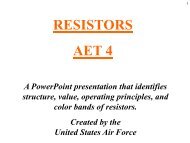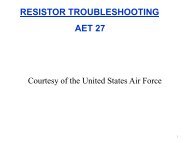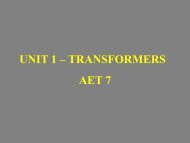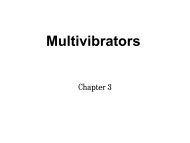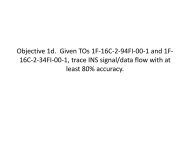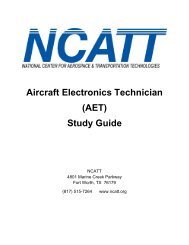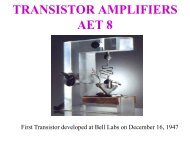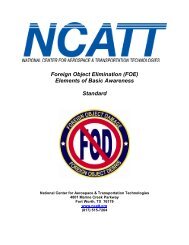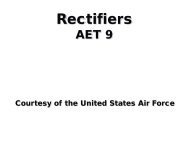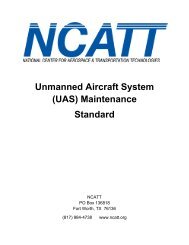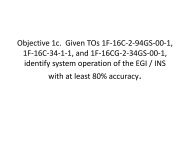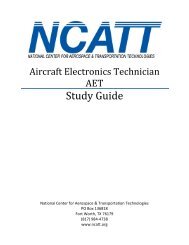Foreign Object Elimination Elements of Basic Awareness ... - NCATT
Foreign Object Elimination Elements of Basic Awareness ... - NCATT
Foreign Object Elimination Elements of Basic Awareness ... - NCATT
You also want an ePaper? Increase the reach of your titles
YUMPU automatically turns print PDFs into web optimized ePapers that Google loves.
Page 13 <strong>of</strong> 16<br />
Instructional Content:<br />
A well-established plan for material handling and parts protection can eliminate many potential FOD hazards.<br />
Example: First identify the specifics such as sensitive parts, assemblies, surfaces, areas, etc. Then identify the<br />
sequence <strong>of</strong> events for packaging, handling, shipping and storage, and finally evaluate cleanliness and care<br />
requirements.<br />
• Control Techniques<br />
o Materials and accessories used in the packaging, handling, shipping and storage that have<br />
intimate contact with the part or assembly should be clean and free <strong>of</strong> contamination.<br />
o Parts and assemblies should be packaged in a manner that will preclude any chance <strong>of</strong> one item<br />
making contact with another during normal handling operations.<br />
o Protective and packaging materials should be chosen based on their ability to adequately resist<br />
penetration by tearing, parting or piercing from forces either external or internal during normal<br />
handling operations.<br />
o Specific instructions for packaging, unpackaging, handling should be followed when provided.<br />
o Protective devices/FOD Barriers (edge protectors, caps, plugs, covers, filters, rub strips) should<br />
be cleaned and secured to prevent accidental damage.<br />
*Refer to <strong>NCATT</strong> Standard #9 for additional information.<br />
o Once installed, unauthorized removal <strong>of</strong> the protective devices is prohibited and should be<br />
controlled through assembly or maintenance paperwork.<br />
• Consideration should be given to the visibility / detection <strong>of</strong> material used for protection so that the<br />
material itself doesn’t become FOD.<br />
• Material Characteristics<br />
o Materials should be compatible with the environmental and physical stresses expected to be<br />
encountered during product service.<br />
o Electro-Static sensitive devices should be properly protected to avoid damage. Materials that are<br />
used to protect electro-explosive devices and sensitive electronic components should be kept<br />
clean, covered, and stored away from ordinary non-static safe materials.<br />
• Condition—Visually inspect all packaging, handling, shipping and storage containers for the<br />
following:<br />
o Nicks, dents, holes, abrasions, scratches, bums, etc., which may be detrimental to the function and<br />
integrity <strong>of</strong> the part or assembly.<br />
o Grease, preservatives, corrosion products, weld slag, shop dirt, and other materials foreign to the<br />
item.<br />
• Packaging / Containers—Packaging methods, materials and processes, including storage and<br />
shipping containers can be a source <strong>of</strong> FOD and could result in damage. In some cases there may be<br />
design considerations for FOD sensitive products, vehicles or assemblies that require the use <strong>of</strong><br />
specific packaging and / or containers. In other applications the design considerations may forbid the<br />
use <strong>of</strong> a specific packaging or container. In all cases the proper packaging and/or containers must be<br />
used.<br />
• Opening and Closing Containers—Caution must be taken when opening and closing containers.<br />
Nailing, strapping or installing screws can cause damage to hardware or provide additional internal<br />
FOD in the container.<br />
• Storage—Follow the established storage procedures to prevent damage. Improper storage procedures<br />
can be a cause <strong>of</strong> <strong>Foreign</strong> <strong>Object</strong> Damage.<br />
Copyright © 2009 by the National Center for Aerospace & Transportation Technologies. All rights reserved.<br />
Individuals may download, print, and make copies <strong>of</strong> this document<br />
for their own personal use. Commercial use prohibited.



